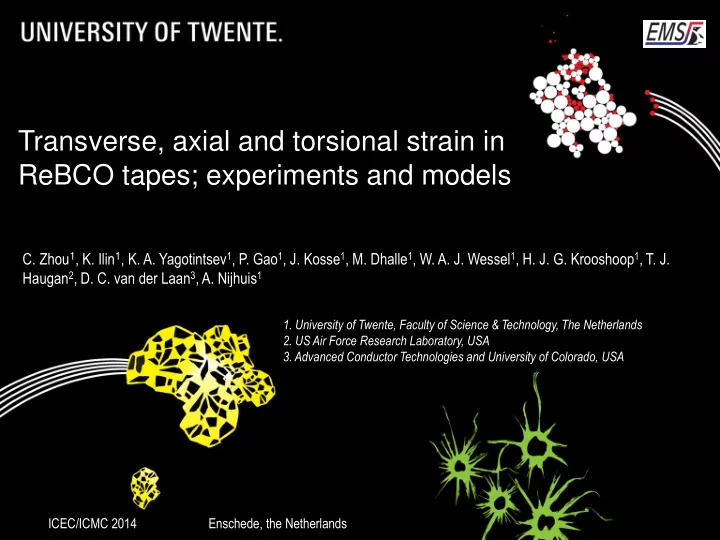

Transverse, axial and torsional strain in ReBCO tapes; experiments and models C. Zhou 1 , K. Ilin 1 , K. A. Yagotintsev 1 , P. Gao 1 , J. Kosse 1 , M. Dhalle 1 , W. A. J. Wessel 1 , H. J. G. Krooshoop 1 , T. J. Haugan 2 , D. C. van der Laan 3 , A. Nijhuis 1 1. University of Twente, Faculty of Science & Technology, The Netherlands 2. US Air Force Research Laboratory, USA 3. Advanced Conductor Technologies and University of Colorado, USA 1 ICEC/ICMC 2014 Enschede, the Netherlands
Outline Introduction Experimental setups ReBCO tape torsion-tensile studies Transverse stress on ReBCO tapes Results and analysis Summary 2
Introduction. ReBCO cabling methods Conductor on Round Core (CORC) D.C. van der Laan, SUST 22, 065013 (2009). Twisted Stack-Tape Cable M. Takayasu, IEEE 23, 4800104 (2013). Roebel Cable W. Goldacker, Journal of Physics, 43 (2006). After test: damaged tapes in outer layers due to Tape performance when subjected cable bending to (combined) torsion, tensile and transverse loading is the key to understand limitations for cable performance. 3
Objective Modeling of the stress-strain Transverse state in a REBCO tape at various loads (temperature, tensile, torsion, transverse load, Torsion etc.) Tensile The ultimate goal is to predict the critical strain level of the tape under cabled conditions ABAQUS software for modelling with mechanical material properties as inputs (from litt & dedicated experiments) Plot of normalized critical current vs. applied axial stress on a 4 mm wide, SCS4050 SuperPower 2G HTS wire 4
ReBCO torsion – tensile test Torsion under controlled axial tensile load by linear stage from TARSIS facility. Sample - SuperPower SCS 4050 tape L-tape=175 mm 5 Vtap pairs Torsional angles used in combiend torsion-tensile tests: 0 0 - 𝜁 𝑢𝑝𝑠 ~0% 300 0 - 𝜁 𝑢𝑝𝑠 ~0.31 % 480 0 - 𝜁 𝑢𝑝𝑠 ~0.5 % 5
Tape transverse stress setup Different types of pushing heads allow to control pushing area and stress. sample Transverse stress at 77 K, calibrated strain gauge for applied force measurement. 6
Modeling Assumptions (ABAQUS) Transverse 0.45 REBCO strain, % Torsion Crack Tensile initiation - Degradation of the critical current depending on the strain state of the REBCO layer at the instant of crack initiation (K. Osamura et al.) 0.7 - Buffer layers and silver layers do not Applied external strain, % significantly influence the mechanical behavior State of residual strain on the REBCO layer as a of the tape function of applied external tensile strain at RT. (Kozo - SCS4050 SuperPower tape for most Osamura et al.) experiments and modeling Configuration of SuperPower 2G HTS Tape SCS4050 7
Modeling: properties of materials Tape SCS4050: It is necessary to model the production process because of the - Substrate thermal residual strain ( ~ -0.2 %) at RT in the REBCO layer. (Hastelloy C-276) Needed: thermal expansion coefficients and elasto-plastic material - Copper properties depending on temperature. (Electroplating) - REBCO 8
Simulation results: tensile Hasttelloy (77K) REBCO strain, % 0.45 Hasttelloy (RT) Crack initiation FEM (77K) Tape (77K) FEM Tape (RT) FEM (RT) 0.7 Cu (77K) Applied external strain, % Cu (RT) State of residual strain on the REBCO layer as a function of applied external tensile strain at RT from neutron diffraction experiment (Kozo Osamura et Tensile test and FEM stress vs. strain data for the al.) and FEM results at RT. tape SCS4050 at RT and 77K. 9
Results: torsion - tensile Applied twist pitch, grad/mm Permanent FEM degradation region Experiment Reversibility region FEM simulation: Tensile – Torsion at 77 K. Longitudinal strain in REBCO layer Critical strain in REBCO layer as a function of applied external tensile strain and applied torsion strain at 77K 10
Transverse stress on SuperPower SCS4050 4mm pushing head 1mm pushing head 0.089 mm 0.084 mm 0.094 mm • Tape thickness not uniform over tape width. • Non homogenous pressure distribution causes early degradation 11
FEM results: transverse load, thickness of the copper Longitudinal strain in ReBCO layer 40 um Cu 100 um Cu REBCO Contact strain Pressure Critical transverse pressure as a function of copper layer thickness at 77K 12
Transverse stress micrographs and SEM 13 13
Summary • Systematic studies of ReBCO tapes under twist, tensile and transverse load were performed. SCS4050 tape shows good Ic reversibility for tensile axial strain up to 𝜁 =0.55%. For • combined torsion – tensile loading, increase in torsion strain leads to earlier and more gradual Ic degradation upon a controlled applied tensile axial strain. • Locally transverse applied stress leads to crack formation mostly at the edges of the pushing area. SEM analysis and modeling are in good agreement for peak in plane strain concentrations. The homogeneity of applied stress plays a significant role just as the thickness of the • tape layers (copper) causing stress concentration spots. 14
Recommend
More recommend